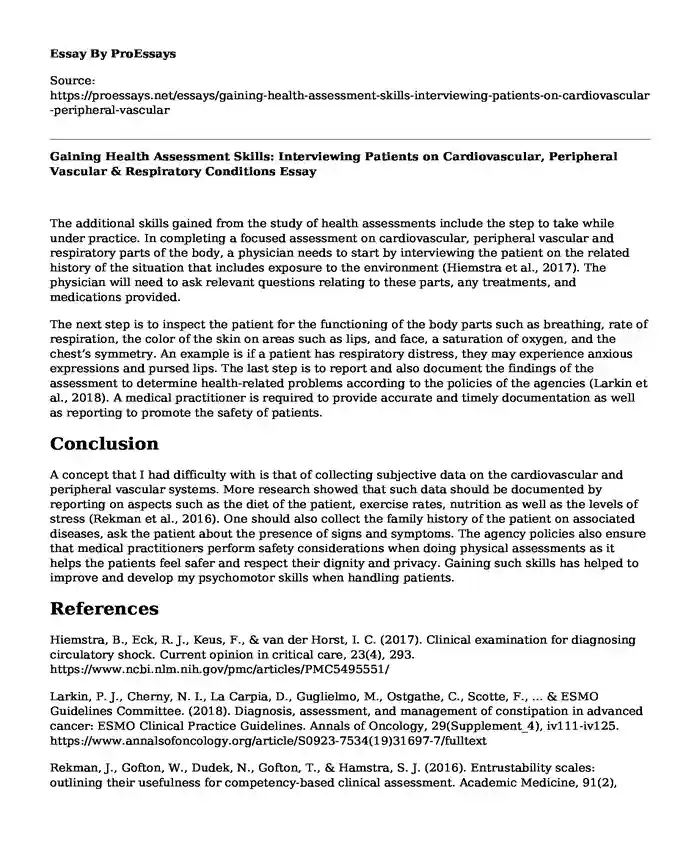The additional skills gained from the study of health assessments include the step to take while under practice. In completing a focused assessment on cardiovascular, peripheral vascular and respiratory parts of the body, a physician needs to start by interviewing the patient on the related history of the situation that includes exposure to the environment (Hiemstra et al., 2017). The physician will need to ask relevant questions relating to these parts, any treatments, and medications provided.
The next step is to inspect the patient for the functioning of the body parts such as breathing, rate of respiration, the color of the skin on areas such as lips, and face, a saturation of oxygen, and the chest’s symmetry. An example is if a patient has respiratory distress, they may experience anxious expressions and pursed lips. The last step is to report and also document the findings of the assessment to determine health-related problems according to the policies of the agencies (Larkin et al., 2018). A medical practitioner is required to provide accurate and timely documentation as well as reporting to promote the safety of patients.
Conclusion
A concept that I had difficulty with is that of collecting subjective data on the cardiovascular and peripheral vascular systems. More research showed that such data should be documented by reporting on aspects such as the diet of the patient, exercise rates, nutrition as well as the levels of stress (Rekman et al., 2016). One should also collect the family history of the patient on associated diseases, ask the patient about the presence of signs and symptoms. The agency policies also ensure that medical practitioners perform safety considerations when doing physical assessments as it helps the patients feel safer and respect their dignity and privacy. Gaining such skills has helped to improve and develop my psychomotor skills when handling patients.
References
Hiemstra, B., Eck, R. J., Keus, F., & van der Horst, I. C. (2017). Clinical examination for diagnosing circulatory shock. Current opinion in critical care, 23(4), 293. https://www.ncbi.nlm.nih.gov/pmc/articles/PMC5495551/
Larkin, P. J., Cherny, N. I., La Carpia, D., Guglielmo, M., Ostgathe, C., Scotte, F., ... & ESMO Guidelines Committee. (2018). Diagnosis, assessment, and management of constipation in advanced cancer: ESMO Clinical Practice Guidelines. Annals of Oncology, 29(Supplement_4), iv111-iv125. https://www.annalsofoncology.org/article/S0923-7534(19)31697-7/fulltext
Rekman, J., Gofton, W., Dudek, N., Gofton, T., & Hamstra, S. J. (2016). Entrustability scales: outlining their usefulness for competency-based clinical assessment. Academic Medicine, 91(2), 186-190. http://medaproc.facmed.unam.mx/wp-content/uploads/2017/11/Entrustability-Scales-Outlining-Their-Usefulness-for-Competency-Based-Clinical-Assessment.pdf
Cite this page
Gaining Health Assessment Skills: Interviewing Patients on Cardiovascular, Peripheral Vascular & Respiratory Conditions. (2023, Nov 06). Retrieved from https://proessays.net/essays/gaining-health-assessment-skills-interviewing-patients-on-cardiovascular-peripheral-vascular
If you are the original author of this essay and no longer wish to have it published on the ProEssays website, please click below to request its removal:
- Benefits of Membership in the Nurse Practitioner Alliance of Alabama
- Tranexamic Acid Use in Traumatic Brain Injury and the Need for Blood Transfusion
- Antibiotic Development Essay Example
- Occupational Therapy Employment Settings Essay Example
- Essay Sample on Sickle Cell Disease: Deformation of Red Blood Cells & Its Health Consequences
- Essential Resuscitation Equipment and Drugs for In-Hospital Cardiopulmonary Arrests - Essay Sample
- Case Study Analysis Example: Treatment & Task Groups







